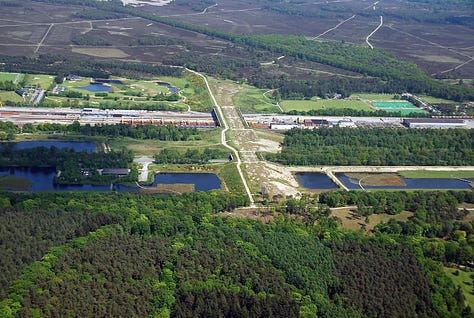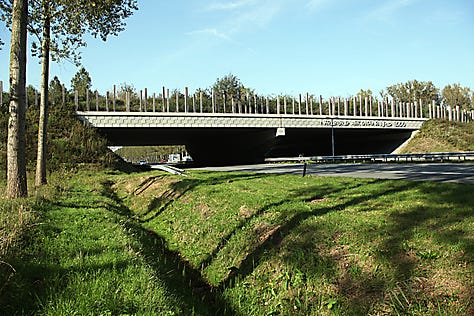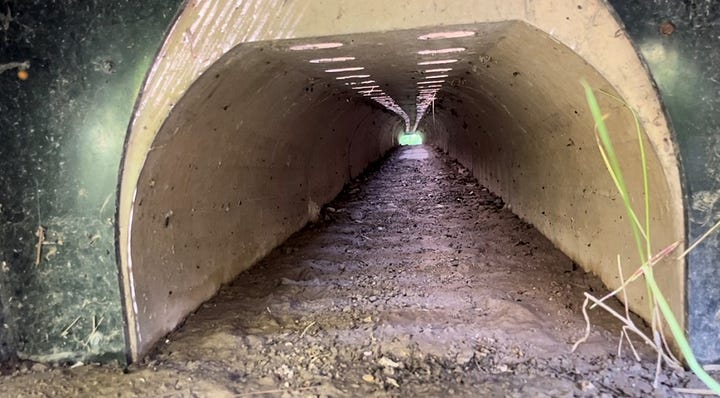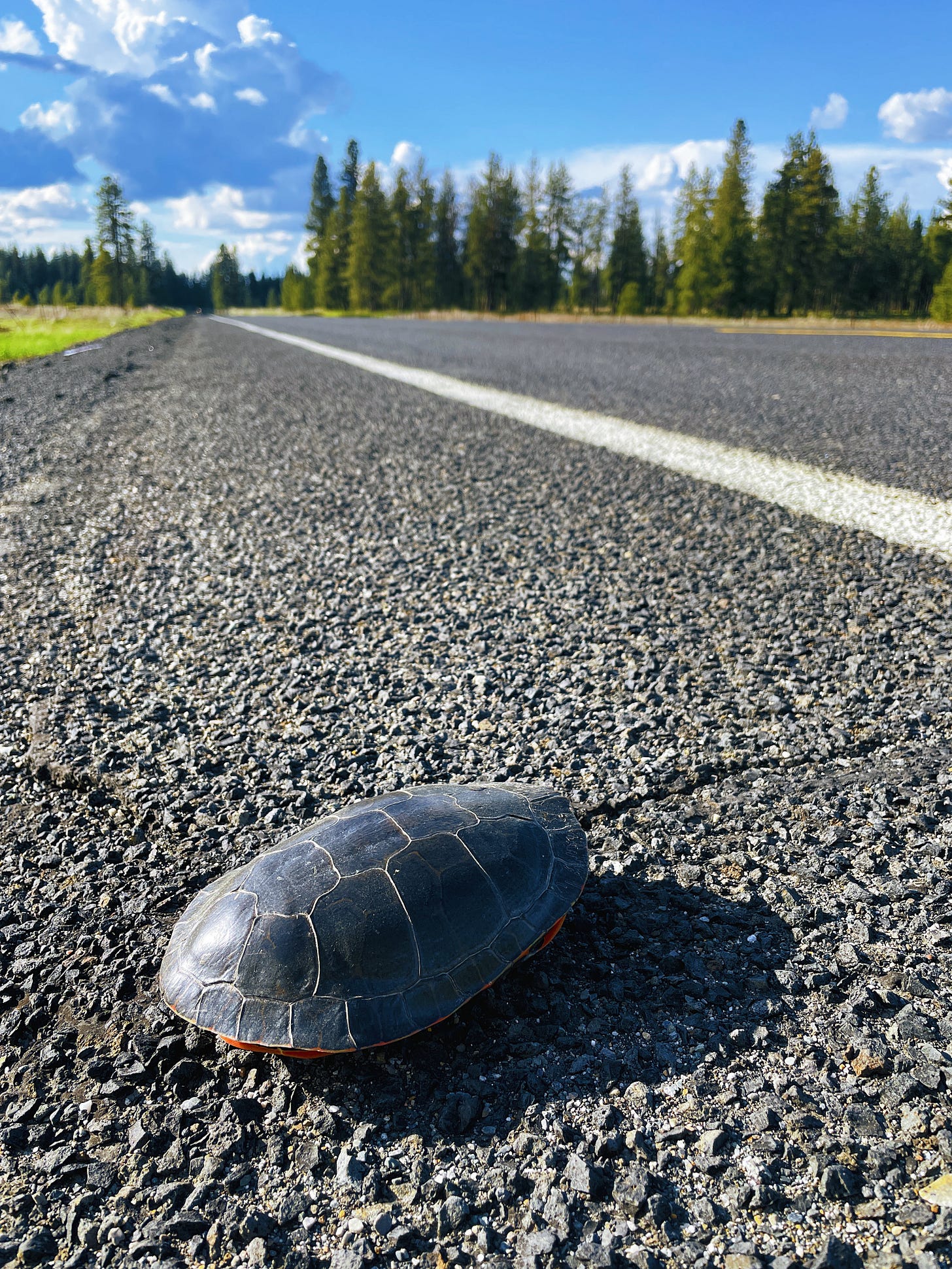Mending the Carpet
7/11/24 - Part 3 of my series on road ecology and wildlife crossings
Hello everyone:
As always, please remember to scroll past the end of the essay to read this week’s curated collection of Anthropocene news.
Now on to this week’s writing:
There is a classic metaphor from David Quammen in his 1996 book Song of the Dodo about the problem of habitat fragmentation. Imagine a fine Persian carpet, he says, in all of its beautiful, incredible detail. Now, with a bit of comic relief, Quammen asks us to imagine taking a very sharp knife and cutting the Persian carpet up into 36 equal square pieces:
The severing fibers release small tweaky noises, like the muted yelps of outraged Persian weavers. Never mind the weavers. When we’re finished cutting, we measure the individual pieces, total them up – and find that, lo, there’s still nearly 216 square feet of recognizably carpetlike stuff. But what does it amount to? Have we got thirty-six nice Persian throw rugs? No. All we’re left with is three dozen ragged fragments, each one worthless and commencing to come apart.
Welcome to habitat in the Anthropocene.
For my purposes here, I’d like you to imagine each of those gaps between pieces of carpet as the roads we drive on, and as threats and barriers to the wildlife surviving in the fragments. Every time a fox or kangaroo or sloth — or a low-flying bird — approaches one of the paved gaps that surround them, the journey across will take them either to the other side or to the Other Side.
Fill many of the cut squares with houses, shops, malls, parking lots, clearcuts, and industrial parks, and watch those habitat fragments become more ragged. Some species – usually small ones, with small ranges – do better than others because they can live out their lives in small zones. But we’re so out of touch with what large-scale healthy habitat looks and feels like that we don’t really notice.
As far as we know, in our daily, busy, harried lives, the remnants of nature are nature, however thinly spread between our house and the next. We live in fragments but think of it as carpet.
Even in larger, wilder landscapes like those in western North America, “logging roads are considered by forest ecologists almost as detrimental to forest health as logging itself,” as Rebecca Wisent of
explained in a comment on the first of these road ecology essays. In her work as a lawyer defending the natural world, she learned that the endless network of logging roads isn’t known for roadkill particularly, but for how its fragmentation of wild places “re-engineers the landscape's hydrology and acts as a drain system, drying out the forest floor on a remarkable scale.” The fragmentation of these forests by roads also increase the prevalence of forest fires, landslides, and the fouling of waterways with sediment. In wild places as well as the suburbs, the presence and movement of people severely diminishes the habitat.Habitat connectivity in much of our built world is not often about linking large landscapes to each other, or at least not on the scale of, say, Wyoming or British Columbia, and it’s not often about large migrating species. Perhaps the largest project in the eastern U.S. is in Florida, where sixty underpasses built or modified for endangered panthers have significantly reduced collisions.
Here in New England, it’s more often about allowing moose and wood frogs to move a short distance to the pond or vernal pool of their heart’s desire. It’s about providing safe wandering for all the usual suspects – deer, skunk, possum, squirrel, fox, turtle, to name a few – through an interrupted forest or wetland. And it’s about re-establishing fish passage past dams (or by removing the dams) and replacing thousands of culverts thrown in decades ago without regard for the movement of other species.
The good news is that in highly fragmented, small-scale landscapes, the principles of road ecology and wildlife crossing design still apply: good site selection, plenty of options, a fencing and crossing strategy, and an invitation to the animals with natural landscaping. In fact, it may be even more essential, because where there are too many fragments there is a need for many more bridges. If there are stretches of road known for wildlife collisions, or if there are particularly threatened species clustered in specific areas, or if there are seasons of high mortality, then there are solutions which can be built and put into place.
The remarkable network of more than 500 “ecoduct” crossings in the small, densely populated Netherlands, is a great example.



Much of the best work in the eastern U.S. is in modifying existing culverts or the terrain under bridges to make them attractive options. This work usually occurs when a bridge or culvert is being updated for other reasons. Maine has done particularly well in this regard.
More than a decade ago, a consortium of organizations (Maine Audubon, The Nature Conservancy, Natural Resources Council of Maine, state and federal agencies, and several more) conspired to create the Stream Smart program, which assessed every stream crossing in the state for its capacity to allow terrestrial or aquatic wildlife passage. They found that about 90% of them made passage difficult or impossible at least part of the year.
That information has been essential to state and municipal planners looking to improve roads and passage at the same time. And it’s vital in a state where water is at the center of wildlife movement: 85% of Maine’s vertebrates live in or use wetlands, ponds, or rivers at least part of the year. The “golden rule” of the Stream Smart program is really two rules: “Let the stream act like a stream,” and “Make the road invisible to the stream.”

Sometimes a state responds to outcry from citizens who refuse to watch helplessly as collisions happen repeatedly in the same place. A great example of this is when frogs and salamanders come out en masse during the first warm, rainy night in spring – known as Big Night – to plod toward the nearest vernal pool. A citizen initiative in Vermont in 2016 led to some very successful frog and salamander tunnels. Likewise, several turtle tunnels have been constructed in New Jersey.


The good news is that these projects, whether for pronghorns, panthers, or painted turtles, can reduce mortality by 80-90%. The bad news is that there will still be lots of carnage. 89% of wildlife collisions in the U.S. occur on two-lane roads, and while these are narrow enough that an underpass is relatively affordable, there are millions of miles to assess for that necessity. Unless there is a radical rethinking of our roads and vehicles, the simple, heartbreaking truth is that even in what may be heady times for the construction of wildlife crossings, much of what we’ve done is triage for the most vulnerable species in the most vulnerable places.
Looking ahead to the extraordinary turbulence of this century, the future of wildlife crossings in a changing climate will be complicated, like everything else. More and more, transportation departments are factoring in wildlife passage and landscape connectivity into their daily function, but how will the habitats they’re trying to keep connected change in a hotter world? Where will species be in fifty years and another 2°C? Which species will remain if the current estimate of a million extinctions worldwide in this century proves true?
This is not just about the migratory mule deer and pronghorn antelope, but the plants they rely on. Not just the perambulatory mountain lions, but their prey too. Not just moose, but their marshes.
It’s essential that we remember, in this discussion about wildlife corridors, that climate and biodiversity are inextricably linked. A crisis in one is a crisis in the other, and worsening crises in both are synergistic. That is, they each accelerate the other. Ecosystems are made of carbon (among other things), and a healthy, flourishing planetary landscape in a stable climate pulls in and stores about the same amount of carbon it emits. A fragmented, diminished, dry and fire-prone landscape emits more carbon than it absorbs. (Already parts of the lush Amazon have become, as they dry, net CO2 emitters.)
Some wisdom on all this may be found in the essential book from Paul Hawken and company, Regeneration: Ending the Climate Crisis in One Generation:
Terrestrial and coastal ecosystems contain more than three billion tons of carbon, nearly four times the amount of carbon contained in the atmosphere. Three decisive actions are required to stop global warming. First, reduce and eliminate emissions from fossil fuel combustion. Second, sequester carbon into the soil by photosynthesis in grasslands, forests, farmlands, mangroves, and wetlands. Third, protect the carbon here on earth… A 15 percent loss of terrestrial carbon could result in a one-hundred-parts-per-million increase in atmospheric carbon dioxide. Establishing wildlife corridors is crucial to preventing that loss.
Why are wildlife corridors crucial? Because the effort to reconnect habitats is an effort to let life thrive, and because the creation of corridors implies a companion effort to protect the habitats that are being connected. Natural stability is the goal. The more species (plants and animals) can live out their lives as they have for millions of years, the more likely the Earth will still be stable and familiar to all of us in a hundred years. The “terrestrial carbon” described above is life itself. Protect life in its marvelous diversity and you keep carbon on and in the ground.
Of course we, in our fossil-fueled imitation of a supervolcano, have changed the planet considerably already and are primed to keep doing it for a while. Which leads to one more reason that wildlife corridors are important in the climate crisis: Because creating and protecting linked landscapes provides room for species to move as they adapt to new weather regimes and altered ecosystems. How much change is coming, how many species can/will adapt, and how much adaptation they will make, is up in the air.
We will see. For now, to mend the carpet and help the civilizational transition to a safer and more humane network of roads, we can advocate in our states to begin or expand efforts to build wildlife crossings. I highly recommend perusing the Animal Road Crossing (ARC) and Center for Large Landscape Conservation (CLLC) websites for a quick education on road ecology, corridors, and crossings.
When CLLC asked Ben Goldfarb what he hoped readers would take away from his amazing book, Crossings: How Road Ecology is Shaping the Future of Our Planet, he said
I hope this book helps people realize just how much we can all do to help wildlife. We can change our own driving habits, for example by driving more slowly and carefully, and less frequently at night. We can become volunteer road ecologists ourselves, by helping to collect the roadkill data that informs future wildlife crossings. And, most importantly, we can publicly support infrastructural fixes like wildlife crossings and fencing, and encourage our elected officials and agencies to build more of them. In a sense, we all contribute to conflicts between roads and wildlife — I’ve hit animals myself. But we’re all part of the solution, too.
Luckily, the Biden administration is working to jumpstart these efforts at the state level with funding from the federal Wildlife Crossings Pilot Program, via the Bipartisan Infrastructure Law. Otherwise, there’s much for states to emulate in the good work being done elsewhere, like the coordination between transportation and fish/wildlife departments in western states and the coalition-led Stream Smart program here in Maine.
It also makes sense to empower citizens to document sightings of roadkill and wildlife on the roads so that highway departments can justify the expense of building crossings. There’s power in data. Unfortunately, while both the Road Ecology Center at UC Davis and CLLC have designed apps for this, neither seems to be widely used. You can learn more about the CLLC app, ROaDS (Roadkill Observation and Data System) here, and the REC app here.
Another good way to help is to support, either financially or by volunteering, your local land trusts, especially on projects that are meant to connect habitat. Here in midcoast Maine Coastal Rivers Conservation Trust and Midcoast Conservancy are doing great work. In the larger Northeast region, the Northeast Wilderness Trust has done remarkable work protecting and connecting larger tracts of land.
As important as it is to push for solutions, it helps to grieve too. We need to contemplate the individual lives who, on their own paths, die on ours. Thanks to Rebecca Wisent again, I’ve just spent some time looking at some beautiful, thoughtful memorials to road-killed animals by anthropologist, professor, conservationist, and photographer Amanda Stronza. It’s transformative to think about the dead on our roads this way.
Finally, I was first motivated to write on wildlife crossings because of this excellent New York Times article, which comes complete with a plethora of happy videos of animals using the crossings. Enjoy.
Drive safe, everyone, and drive with care. If you see a Caution sign about wildlife crossing ahead – especially moose – pay attention.
Every stretch of road is a possible intersection with an animal on its own path.
Thanks for sticking with me.
In other Anthropocene news:
It is simply too hot, everywhere. From the Times’ David Wallace-Wells, though, a reminder that this is just the beginning of a planet (and its human population) transformed by excess heat. Wallace-Wells focuses on the recent spate of heat waves around the globe to make a larger point about what’s coming and how we’re thinking (and not thinking) about it.
But added heat, in little homemade saunas, is helping threatened frogs infected with chytridiomycosis (a fungus wiping out amphibians globally) survive. From the Post.
From Mother Jones (and a coalition of investigative reporting), “forever chemical” PFAS substances are built into lithium-ion EV batteries, and we’re likely looking at a long future of dealing with the usual problems from a chemical industry which lies, hides, distracts, and conspires to protect its profits and defend against taking responsibility.
I highly recommend anyone interested in a deeper, wider, and more knowledgeable weekly survey of nature and biodiversity news to read the Global Nature Beat from
. His latest, Nature Beat #35, includes his usual astonishing array of in-the-trenches info from the U.N. agencies working to protect life on Earth, updates on how politics and policies in countries around the globe are influencing nature protection, studies of what conservation work is and isn’t achieving, and much much more. Check it out.From Mother Jones, a new study makes clear just how vulnerable to pollution U.S. waterways now are, in the wake of last year’s Supreme Court disastrous, half-witted decision in Sackett v. EPA to remove protections from “ephemeral” streams. More than half of the water flow in the U.S. first passes through ephemeral (seasonal or occasional) streams, but SCOTUS decided against both rational and scientific understanding that wetlands and streams not continuously flowing were not covered by the Clean Water Act. In doing so, the court deprived half the nation’s wetlands, about 90 million acres of marshy areas, from protection.
From the Times, there’s a serious squabble for leadership at the International Seabed Authority, a small U.N. agency tasked with managing the sea floor across most of the planet. The ISA is at the center of the storm over whether or not to permit seabed mining, which would ravage habitats undisturbed for many millions of years and about which we know almost nothing. The two candidates are more or less on opposite sides of the issue, and are both accusing the other of improper behavior. But I’m hopeful that the incumbent will be rejected and that permitting will be delayed for several years, at which point battery technology will have advanced to a point that will make destroying the deep sea unnecessary.
Also from the Times, a plea from a scientist for serious investment in taxonomy, the science of naming and classifying species, as a necessary tool for saving life on Earth. Taxonomy has lost support in the wake of molecular genetics, which offers incredible precision in describing differences between life forms, but taxonomy provides a public face of that information. “How we delineate between species,” the author of this op-ed says, “determines what we choose to save.”
From Mongabay, a new study finds that more of the Amazon rainforest is conserved than previously known. More than 40% of the region is under some form of protection and management, but it is still far from enough.
Also from Mongabay, a fascinating analysis of pollen from dozens of flowering plant species has determined which seem best for the nutrition and health of bee species in North America. There is much that is interesting here, including evidence on the need for floral diversity to keep bees healthy, the variation in amino acids from one type of pollen to another, and the fact that the nutrition of pollen from invasive plants did not differ much from natives.
From Nautilus, an important personal account from an Antarctic atmospheric scientist, “How we Solved the Hole in the Ozone.” Too few people today understand either the global threat posed by the man-made deterioration of the planet’s ozone layer or the remarkable accomplishment of the 1987 Montreal Protocol, the international agreement which banned the chemicals that caused most of the harm.
From Vox, how the meat industry uses public universities to improve their reputation, hoping to “prop up an industry that has been implicated in animal cruelty, zoonotic disease risk, and environmental harms.” One expert described it as
sort of like increasing public trust in coal mining-based energy production, lead-based paint manufacturing, leaded fuel-dependent transportation, asbestos-dependent construction methods, or DDT-based pest control.






I love this ending to the series. Wildlife crossings (and deliberate corridors more generally) are just the coolest.
If anyone wants to know the polar opposite of man's roads, especially in the fields we create of our plantings- it is hedgerows, where nature reigns untrammelled. I remember them well from childhood- long lines of green in the cornfields of my state. By leaving these roads of unplowed, unmodified forest we were performing a service to the land. A first step to re-wilding would be for the creation of more of these roads paved with shrubs and grasses and trees in the vast barrens of the crop fields.